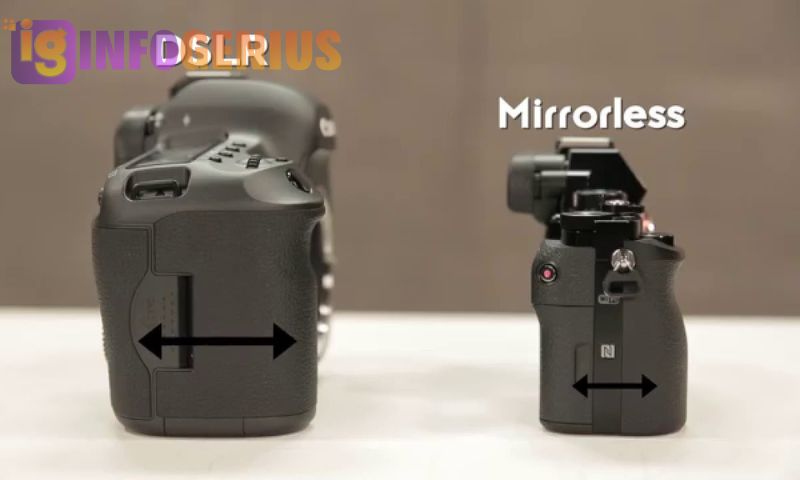Introduction to DSLR vs Mirrorless Camera
When it comes to choosing the perfect camera, the DSLR vs mirrorless camera debate is one of the most common among photographers. Both types of cameras offer unique advantages, making it challenging to decide which is best for your needs. While DSLRs have been the go-to choice for professionals for years, mirrorless cameras are rapidly gaining popularity due to their compact size and advanced technology. In this article, we will explore the differences between DSLR and mirrorless cameras, helping you make an informed decision.
Understanding DSLR vs Mirrorless Camera: The Basics
Before diving into the pros and cons, it’s essential to understand the basic differences between a both cameras. A DSLR (Digital Single-Lens Reflex) camera uses a mirror mechanism to reflect light into an optical viewfinder. When you press the shutter button, the mirror flips up, allowing light to hit the image sensor and capture the photo. On the other hand, a mirrorless camera lacks this mirror mechanism, relying solely on an electronic viewfinder or LCD screen for image composition.
Image Quality: DSLR vs Mirrorless Camera

One of the most crucial factors in choosing between a DSLR vs mirrorless camera is image quality. Both camera types use large image sensors, which result in high-quality photos with excellent detail and dynamic range. DSLRs have traditionally been favored for their ability to handle different lighting conditions and produce superior image quality. However, modern mirrorless cameras have caught up significantly, offering comparable image quality with advanced image processing capabilities.
Size and Portability: DSLR vs Mirrorless Camera
If portability is a priority, then a both cameras comparison leans heavily in favor of mirrorless cameras. DSLRs tend to be bulkier and heavier due to their internal mirror system and larger body design. Mirrorless cameras, in contrast, are compact and lightweight, making them an excellent choice for travel and street photography. The smaller size of mirrorless cameras allows photographers to carry them around more conveniently without compromising on performance.
Autofocus Performance: DSLR vs Mirrorless Camera
Autofocus is another critical aspect to consider in the both cameras debate. DSLRs use phase-detection autofocus, which is known for its speed and accuracy, especially in well-lit environments. Mirrorless cameras, however, utilize contrast-detection or hybrid autofocus systems that combine both phase-detection and contrast-detection. Many modern mirrorless cameras now outperform DSLRs in autofocus speed, particularly in video recording and fast-moving subjects.
Lens Selection: DSLR vs Mirrorless Camera
When it comes to lens availability, both cameras discussions often highlight that DSLRs have the upper hand. DSLRs have been around for decades, and they offer a vast range of lenses from various manufacturers. Mirrorless cameras, while growing in popularity, have a more limited selection of native lenses. However, many brands provide adapters that allow mirrorless cameras to use DSLR lenses, bridging the gap between the two systems.
Battery Life: DSLR vs Mirrorless Camera
Battery life is a significant consideration in the DSLR vs mirrorless camera debate. Due to the absence of an optical viewfinder, mirrorless cameras rely on electronic viewfinders and LCD screens, which consume more power. DSLRs, on the other hand, can shoot more photos on a single charge, making them ideal for long photography sessions. If battery longevity is crucial, DSLRs are generally the better option, although advancements in mirrorless technology are improving battery efficiency.
Video Capabilities: DSLR vs Mirrorless Camera

For videographers, the both camera choice depends on specific needs. Mirrorless cameras have gained an edge in video recording due to their superior autofocus systems and 4K video capabilities. Most mirrorless cameras offer advanced video features such as in-body stabilization, better frame rates, and improved focus tracking. While DSLRs can also capture high-quality videos, they often lack the same level of autofocus performance, making mirrorless cameras the preferred option for videographers.
Durability and Build Quality: DSLR vs Mirrorless Camera
Durability plays a vital role in the both camera comparison. DSLRs are typically built with rugged bodies, weather sealing, and sturdy construction, making them reliable for outdoor photography. Mirrorless cameras, though compact, are catching up in terms of build quality, with many high-end models offering weather-sealed bodies. However, DSLRs are still preferred for extreme weather conditions and rugged environments.
Price and Affordability: DSLR vs Mirrorless Camera

Price is a crucial factor when choosing between a DSLR vs mirrorless camera. Entry-level DSLRs are generally more affordable than entry-level mirrorless cameras. However, as you move to professional-grade models, the price difference becomes less significant. Mirrorless cameras often come with advanced features that justify their higher price, but budget-conscious photographers might find DSLRs to be a more cost-effective option.
Future of Photography: DSLR vs Mirrorless Camera
The future of photography is leaning towards mirrorless technology, with many major camera brands focusing on developing mirrorless systems. This cameras landscape is shifting, as companies like Canon, Nikon, and Sony invest heavily in mirrorless innovations. While DSLRs are still widely used and respected, mirrorless cameras are becoming the preferred choice due to their technological advancements and ease of use.
Who Should Buy a DSLR vs Mirrorless Camera?
Choosing between a DSLR vs mirrorless camera depends on your specific needs. If you prefer a traditional shooting experience with optical viewfinders, long battery life, and extensive lens options, a DSLR might be the best choice. However, if you value portability, superior video capabilities, and cutting-edge technology, a mirrorless camera would be more suitable. Consider your photography style, budget, and long-term goals when making a decision.
FAQs
1. Which camera type is better for beginners?
Both DSLRs and mirrorless cameras are great for beginners, but mirrorless cameras tend to be easier to use due to their compact size and advanced autofocus.
2. Do mirrorless cameras have better image quality than DSLRs?
Both types offer excellent image quality. However, mirrorless cameras are catching up quickly with improved sensors and image processing.
3. Are DSLRs becoming obsolete?
While mirrorless cameras are the future, DSLRs are still widely used by professionals and enthusiasts who prefer their durability and battery life.
4. Can I use DSLR lenses on a mirrorless camera?
Yes, many mirrorless cameras support adapters that allow you to use DSLR lenses.
5. Which camera type is better for video recording?
Mirrorless cameras generally offer better video features, including superior autofocus, 4K video, and in-body stabilization.
Conclusion
The DSLR vs mirrorles camera debate ultimately comes down to personal preference and photography requirements. Both camera types offer impressive features, and the right choice depends on what matters most to you. Whether you opt for the reliable and time-tested DSLR or the modern and innovative mirrorless camera, investing in the right camera will enhance your photography experience. As technology continues to evolve, mirrorless cameras are becoming increasingly dominant, but DSLRs still have their place for many photographers. Choose wisely, and enjoy capturing stunning images with the perfect camera for your needs.






